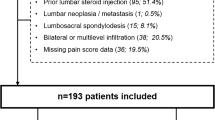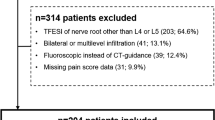Abstract
Objectives
To determine whether specific MRI findings are related to outcomes after lumbar transforaminal epidural steroid injections (TFESI) and to assess the inter-rater reliability of imaging diagnosis.
Materials and methods
A prospective outcomes study on 156 consecutive patients with 1-month follow-up outcomes data and MRI within 3 months of TFESI was conducted. Pain levels (numerical rating scale) (NRS) were recorded prior to injection. Overall ‘improvement’ was determined using the Patients Global Impression of Change (PGIC) scale and NRS data were collected at three time points post injection. Two radiologists independently evaluated all images blinded to treatment outcome for reliability of diagnosis. The Chi-square test compared MRI findings for the senior radiologist to ‘improvement’. NRS change scores were compared to MRI findings with the unpaired t-test or ANOVA. Kappa and percent agreement assessed inter-rater agreement of diagnosis.
Results
The only abnormality linked to ‘improvement’ (p = 0.03) and higher NRS change scores (p = 0.0001) at 1 month was the disc herniation morphology ‘protrusion + sequestration’. Patients with degeneration by osteophytes (p = 0.034), grade 3 foraminal nerve root compression (p = 0.01) and foraminal/extraforaminal location of herniation (p = 0.014) also had higher 1 month NRS change scores. Reliability of diagnosis was ‘fair’ to ‘substantial’ depending on MRI findings.
Conclusions
Patients with disc protrusion plus sequestration were significantly more likely to report overall improvement and more pain reduction at 1 month. Higher pain reduction was noted in patients with degeneration by osteophytes, grade 3 foraminal nerve root compression, or foraminal/extraforaminal disc herniation location.




Similar content being viewed by others
References
Gore M, Sadosky A, Stacey BR, Tai KS, Leslie D. The burden of chronic low back pain: clinical comorbidities, treatment patterns, and health care costs in usual care settings. Spine. 2012;37:E668-77.
van Tulder M, Koes B, Bombardier C. Low back pain. Best Pract Res Clin Rheumatol. 2002;16:761–75.
Burton AK, Balagué F, Cardon G, et al. Chapter 2. European guidelines for prevention in low back pain. Eur Spine J. 2006;15(Suppl)2:S136–68.
Stewart WF, Ricci JA, Chee E, Morganstein D, Lipton R. Lost productive time and cost due to common pain conditions in the US workforce. JAMA. 2003;290:2443–54.
Wieser S, Horisberger B, Schmidhauser S, et al. Cost of low back pain in Switzerland in 2005. Eur J Health Econ. 2011;12:455–67.
Ricci JA, Stewart WF, Chee E, Leotta C, Foley K, Hochberg MC. Back pain exacerbations and lost productive time costs in United States workers. Spine. 2006;31:3052–60.
Wassenaar M, van Rijn RM, van Tulder MW, et al. Magnetic resonance imaging for diagnosing lumbar spinal pathology in adult patients with low back pain or sciatica: a diagnostic systematic review. Eur Spine J. 2012;21:220–7.
Balagué F, Dudler J. An overview of conservative treatment for lower back pain. Int J Clin Rheumatol. 2011;6:281–90.
Manchikanti L, Buenaventura RM, Manchikanti KN, et al. Effectiveness of therapeutic lumbar transforaminal epidural steroid injections in managing lumbar spinal pain. Pain Physician. 2012;15:E199–245.
Manchikanti L, Nampiaparampil D, Manchikanti K, et al. Comparison of the efficacy of saline, local anesthetics, and steroids in epidural and facet joint injections for the management of spinal pain: a systematic review of randomized controlled trials. Surg Neurol Int. 2015;6:S194–235.
Peterson C, Hodler J. Evidence-based radiology (part 1): is there sufficient research to support the use of therapeutic injections for the spine and sacroiliac joints? Skeletal Radiol. 2010;39:5–9.
Lee JW, Choi SW, Park SH, Lee GY, Kang HS. MR-based outcome predictors of lumbar transforaminal epidural steroid injection for lumbar radiculopathy caused by herniated intervertebral disc. Eur Radiol. 2013;23:205–11.
Choi SJ, Song JS, Kim C, et al. The use of magnetic resonance imaging to predict the clinical outcome of non-surgical treatment for lumbar intervertebral disc herniation. Korean J Radiol. 2007;8:156–63.
Ghahreman A, Bogduk N. Predictors of a favorable response to transforaminal injection of steroids in patients with lumbar radicular pain due to disc herniation. Pain Med. 2011;12:871–9.
Fardon DF, Milette PC. Nomenclature and classification of lumbar disc pathology. Recommendations of the combined task forces of the North American Spine Society, American Society of Spine Radiology, and American Society of Neuroradiology. Spine. 2001;26:E93–113.
Pfirrmann CW, Dora C, Schmid MR, Zanetti M, Hodler J, Boos N. MR image-based grading of lumbar nerve root compromise due to disk herniation: reliability study with surgical correlation. Radiology. 2004;230:583–8.
Lee S, Lee JW, Yeom JS, et al. A practical MRI grading system for lumbar foraminal stenosis. Am J Roentgenol. 2010;194:1095–8.
Schizas C, Theumann N, Burn A, et al. Qualitative grading of severity of lumbar spinal stenosis based on the morphology of the dural sac on magnetic resonance images. Spine. 2010;35:1919–24.
Lechmann M, Peterson CK, Pfirrmann CW, Hodler J. Lumbar nerve root injections: a prospective cohort outcomes study comparing age- and gender-matched patients who returned an outcomes-based postal questionnaire with patients who did not return the postal questionnaire. Skeletal Radiol. 2013;42:1429–35.
Childs JD, Piva SR, Fritz JM. Responsiveness of the numeric pain rating scale in patients with low back pain. Spine. 2005;30:1331–4.
Newell D, Bolton JE. Responsiveness of the Bournemouth questionnaire in determining minimal clinically important change in subgroups of low back pain patients. Spine. 2010;35:1801–6.
Farrar JT, Young JP, LaMoreaux L, Werth JL, Poole RM. Clinical importance of changes in chronic pain intensity measured on an 11-point numerical pain rating scale. Pain. 2001;94:149–58.
Fardon DF, Williams AL, Dohring EJ, Murtagh FR, Gabriel Rothman SL, Sze GK. Lumbar disc nomenclature: version 2.0: recommendations of the combined task forces of the North American Spine Society, the American Society of Spine Radiology and the American Society of Neuroradiology. Spine J. 2014;14:2525–45.
Landis JR, Koch GG. The measurement of observer agreement for categorical data. Biometrics. 1977;33:159–74.
Janardhana AP, Rajagopal, Rao S, Kamath A. Correlation between clinical features and magnetic resonance imaging findings in lumbar disc prolapse. Indian J Orthop. 2010;44:263–9.
Rehman IU, Hamid RS, Akhtar W, Naqi R, Shamim MS. Observer variation in MRI evaluation of patients with suspected lumbar disc herniation and nerve root compression: comparison of Neuroradiologist and Neurosurgeon’s interpretations. J Pak Med Assoc. 2012;62:826–9.
Fu MC, Buerba RA, Long WD, et al. Interrater and intrarater agreements of magnetic resonance imaging findings in the lumbar spine: significant variability across degenerative conditions. Spine J. 2015;14:2442–8.
Bensler S, Sutter R, Pfirrmann CW, Peterson CK. Long term outcome from CT-guided indirect cervical nerve root blocks and their relationship to the MRI findings: a prospective study. Eur Radiol. 2015;25:3405–13.
Author information
Authors and Affiliations
Corresponding author
Ethics declarations
Conflict of interest
The authors declare that they have no conflict of interest.
Rights and permissions
About this article
Cite this article
Lechmann, M., Rosskopf, A., Ehrmann, C. et al. Relationship of specific MRI findings to treatment outcomes in patients receiving transforaminal epidural steroid injections. Skeletal Radiol 45, 1677–1685 (2016). https://doi.org/10.1007/s00256-016-2487-3
Received:
Revised:
Accepted:
Published:
Issue Date:
DOI: https://doi.org/10.1007/s00256-016-2487-3




